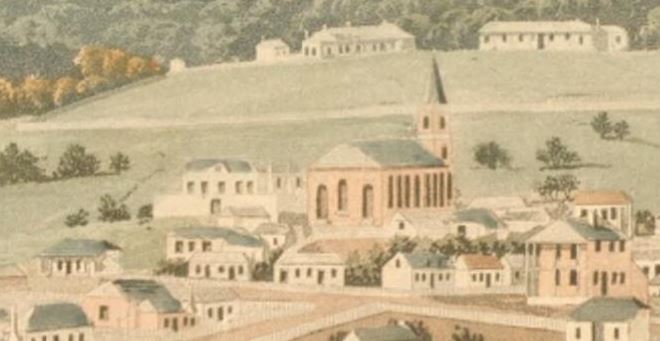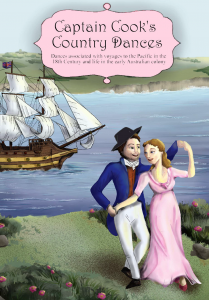
The dance and music for Van Dieman’s Bells [sic] was published in London in 1825. This is a very special dance – the first English dance created in recognition of Van Diemen’s Land (modern day Tasmania). It may have celebrated the new church bells of the remote colony and capitalising on the emerging interest in colonial Australia.
The first ring of bells in Hobart Town
A major event in the small town of Hobart was the consecration of St David’s church in 1823. Lieutenant-Governor William Sorrell had directed that the new church should be named “out of respect to the Memory of Colonel David Collins”. Appointed Lieutenant-Governor of the newly founded settlement of Van Diemen’s Land in 1804, Collins had remained in the post until his death in 1810.


A place of worship had been constructed over Collins’ grave in 1810, however, this temporary shelter was blown away two years later during a tempest. The foundation stone of the new church was laid on the corner of Murray and Macquarie Streets on 19 February 1817. It took some years for the building to be completed, but in January 1823, it was consecrated by the Reverend Samuel Marsden, Senior Chaplain of New South Wales, who visited Hobart Town under Commission of the Archbishop of Canterbury.

The consecration of St David’s was announced in the Hobart Town Gazette and Van Diemen’s Land Advertiser (1823, February 15).
The church with its distinctive pink spire is prominent in many early depictions of Hobart. The bells not only called the faithful to worship, but also heralded the demise of law breakers as “the wretched men were launched into eternity” on the gallows.

Within a year another church had opened its doors in the capital of Van Diemen’s Land. The Scots Church, “the first Presbyterian Church erected in these Colonies” was described as small, yet elegant and commodious. The first service was attended by the newly appointed Lieutenant-Governor, George Arthur, who was “attentive to the eloquent, impressive, and appropriate discourse by the Rev. A. McArthur.” The “little stone kirk” in Bathurst Street was well attended by people of Scottish birth or descent who missed their native form of worship.

Settlers
At this time Van Diemen’s land was beginning to attract free settlers. The aftermath of the Napoleonic wars created social unrest in Britain with low wages, high food prices, and an increasing population. Leaving these troubles behind by emigrating was an appealing option. An article in The Scots Magazine noted: “Colonies are not now to Britain the pillars of her prosperity, but the refuge of her distress, where men can secure the food and raiment that home denies them.”
Hobart Town was reported as a favourable destination for colonists “seeking the farthest boundaries of the earth”. By the 1820s it had grown into substantial town, laid out with regular streets, a government-house, a handsome church, a commodious military barrack, a strong gaol, a well-constructed hospital, and a roomy barrack for convicts.
A report describing Van Diemen’s Land in The Scots Magazine presents a glowing depiction of Hobart as a potential destination for free settlers.
“Van Diemen’s Land.” The Scots Magazine, vol. X, 1 June 1822, pp. 772
Van Dieman’s Bells
Van Dieman’s Bells was published by the London dancing master Mordaunt Levien in his collection of English country dances in 1825.

Courtesy of Dance Away Library (the private collection of William Litchman)
Levien’s book of twenty-five dances is his only known publication in this genre. It presents a distinctive social history of the early 1820s, featuring a variety of topical events, fashionable celebrities, and artistic works. The only existing copy of this book is held in the Dance Away Library.

Mr Levien taught dancing in Bedford Square, an upper middle class residential area of London where he offered tuition in quadrilles, waltzing, minuets and country dancing at the cost of one guinea for six lessons. At his “Select Assembly” in the Crown and Anchor on 2nd February 1820, his ball opened precisely at 9 o’clock, with the Minuet de la Cour and Gavot, followed later in the evening with a Fandango composed by Mr Levien himself.

Van Dieman’s Bells
Dance instructions
Country dance: Duple minor longways.
| A | 1-8 | 1st couple full figure of eight around 2nd couple. Alternatively: Double figure of eight with 1st couple crossing diagonally down, and 2nd couple casting up to begin. |
| B | 1-8 | 1st couple lead down the middle and back |
| A | 1-8 | 1st and 2nd couples poussette one and a half times to change places. |
William Litchman, curator of the Dance Away Library writes, “Winifred Agnes Shuldham-Shaw, the previous owner (and probably binder of the collection – bound by H. Newling Whitchurch) made hand-written notes (pencil) on the inside front and back binding papers. In those notes, she mentions Levien’s 1825 publication more than any other, commenting on the value of the music as well as the interest of some of the figures used in the dances, including Van Dieman’s Bells.”

References

Image courtesy of Harvey Reid’s Partial Capo.com
Mordaunt Levien and the harp-lute. http://www.partialcapo.com/early_capo_history.htm
Mordaunt Levien and his Instruments. Hayato Sugimoto. (2018). Galpin Society Journal, 71, 57-275.
Several guitar-harps created by Levien are still in existence. https://vintage-instruments.com/shop/historical/historical-stringed-and-fretted/mordaunt-levien-guitare-harpe-c-1825-paris/
St David’s Cathedral, Hobart. Official website http://saintdavids.org.au/past-present/history/
Foundation stone of St David’s GOVERNMENT AND GENERAL ORDERS. (1817, February 22). The Hobart Town Gazette and Southern Reporter (Tas. : 1816 – 1821), p. 1. Retrieved June 14, 2022, from http://nla.gov.au/nla.news-article652294
Naming of St David’s Government and General Orders. (1820, September 23). The Hobart Town Gazette and Southern Reporter (Tas. : 1816 – 1821), p. 2. Retrieved June 14, 2022, from http://nla.gov.au/nla.news-article658362
Consecration. HOBART-TOWN. (1823, February 15). Hobart Town Gazette and Van Diemen’s Land Advertiser (Tas. : 1821 – 1825), p. 2. Retrieved June 14, 2022, from http://nla.gov.au/nla.news-article1089848
Executions. (1827, January 12). Colonial Times and Tasmanian Advertiser (Hobart, Tas. : 1825 – 1827), p. 4. Retrieved June 14, 2022, from http://nla.gov.au/nla.news-article2449245
Scots Church, Hobart. https://www.scotschurch.com.au/history-3/
Watch the Van Dieman’s Bells video at https://youtu.be/7mNR2MSy7-Q







4 Responses to Van Dieman’s Bells